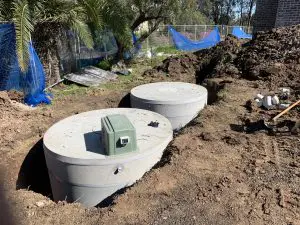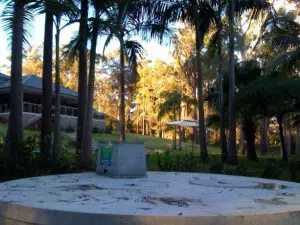Clogs and Blockages Problem:
Clogs and blockages are one of the most frequent issues with septic systems. When wastewater travels from your home to your septic tank, it’s filtered and broken down by bacteria. But if foreign materials are introduced, they can clog pipes, block flow, or create backups in your drains and toilets. This can lead to unpleasant smells, slow drainage, or even complete blockages that result in sewage backups inside the home.
How to Avoid It:
Never Flush Non-Biodegradable Items: This is the #1 rule. Items like baby wipes, paper towels, feminine hygiene products, and cotton balls are a leading cause of septic system clogs. Even if they say they are “flushable,” these items don’t break down easily in a septic tank. Always dispose of them in the trash instead.
Use Toilet Paper Sparingly: While toilet paper is designed to break down, using excessive amounts can still contribute to blockages. Try to use it sparingly, and if you have a large family, consider a high-quality, quick-dissolving brand that won’t take as long to break down.
Avoid Pouring Grease Down the Drain: Grease, oils, and fats can solidify in the pipes, creating blockages in your septic system. Always dispose of grease and cooking oils in the trash, not the sink.
Signs of a Blockage:
Toilets or sinks draining slowly
Unpleasant odors near drains or septic tank
Gurgling noises from pipes
Septic Tank Overflows
Problem:
Septic tank overflows happen when the tank becomes too full, typically because it hasn’t been pumped in a long time. When solids accumulate and the tank reaches capacity, they can overflow into the drain field, causing messy backups and unpleasant odors. Overflows can damage your tank and drain field, resulting in expensive repairs.
How to Avoid It:
Regular Pumping: One of the easiest and most effective ways to prevent overflows is by keeping up with regular septic tank pumping. Typically, a septic tank needs to be pumped every 3-5 years, depending on its size, the number of people in your household, and how much water you use. Regular pumping ensures that solids don’t build up and clog the system.
Monitor Water Usage: Excessive water use can overwhelm your septic system, especially during heavy rainfall or in homes with many occupants. Fix any leaks in faucets or toilets, and try to conserve water wherever possible. Small habits like shortening showers, fixing dripping faucets, and running dishwashers and washing machines with full loads can make a big difference.
Signs of Overflow:
Standing water or damp spots above the drain field
Sewage odors around the yard or inside the house
Toilets and drains backing up
Slow drainage or bubbling toilets
Foul Odors Problem:
Foul odors coming from your septic system can be a sign of trouble, especially if the smell is noticeable inside or near the tank. This could indicate that the system is overloaded, the bacteria in the tank aren’t breaking down waste properly, or that there’s a clog somewhere in the pipes. If left unaddressed, persistent odors can affect your home and property.
How to Avoid It:
Ensure Proper Bacteria Balance: Healthy bacteria are crucial for breaking down waste in your septic system. If the bacterial population is out of balance, waste may not be broken down properly, leading to odors and possible system failure. Avoid using harsh chemicals (like bleach, drain cleaners, and antibacterial soaps) that can kill beneficial bacteria in your septic tank.
Pump Regularly: As mentioned, regular pumping helps keep your system from becoming overrun with waste. An overflowing or stagnant septic tank is a common source of bad smells.
Signs of Odors:
Foul smells near the drain field or tank
Bad odors in your drains or toilet bowls
The smell of sewage in your home, especially in the basement or lower levels
Drain Field Failure Problem:
The drain field, or leach field, is where treated wastewater from the septic tank is filtered into the soil. If the drain field becomes clogged or fails, wastewater can back up into the tank or leach into your yard. This can lead to standing water in your yard, foul odors, and the risk of contamination of nearby water sources.
How to Avoid It:
Keep the Drain Field Clear: The area above your drain field should be kept free of trees, shrubs, and heavy vehicles. Roots from trees can infiltrate the pipes, and heavy machinery can compact the soil, both of which reduce the effectiveness of the drain field.
Avoid Overloading the System: The drain field can become overwhelmed if your septic system is overburdened with waste. Overuse of water, especially with large households or frequent guests, can reduce the drain field’s capacity. Be mindful of water usage and try not to overload the system with excess waste.
Maintain a Healthy Bacteria Level: As with the septic tank itself, the bacteria in your drain field play a key role in breaking down waste. Avoid chemicals that could harm the bacteria in the drain field, such as excessive chlorine or cleaning products.
Signs of Drain Field Failure:
Standing water or soggy patches on your lawn, especially near the drain field
Persistent bad odors near the drain field
Slow draining sinks and toilets
Tree Root Intrusion
Problem:
Tree roots are a common but often overlooked problem for septic systems. Roots can infiltrate septic system pipes and tanks, leading to clogs, leaks, and even pipe damage. As the roots grow, they seek out moisture, and a septic system provides an ideal source of water. If left untreated, tree root intrusion can cause significant damage to the system and require costly repairs.
How to Avoid It:
Plant Trees Carefully: When planting trees near your septic system, make sure they are a safe distance away from your pipes and tank. Root systems tend to spread wide, so be cautious of tree species with aggressive roots, such as willows, maples, and oaks.
Install Root Barriers: If you’re planting trees near your septic system, consider installing root barriers to prevent roots from growing into the pipes.
Regular Inspection: If you suspect tree roots may be infiltrating your system, consider having a professional inspect your pipes and tank to ensure there are no blockages or damage.
Signs of Tree Root Intrusion:
Slow drainage or frequent backups
Visible roots near septic tank or drain field
Unexplained damage or leaks in pipes
Related Posts
- Domestic Treatment Plants
- Choosing the Right Septic Tank Additives: What Works and What to Avoid
- Graham’s Precast Concrete Products – Coffs Harbour – Northern Rivers Region
- What is the Best Domestic Sewage Treatment Plant? – Copy
- Revitalize Your AWTS for the New Year: A Comprehensive Guide to Yearly Servicing
- Eco-Septic Wastewater Treatment Systems Tailored To Your Needs
- Macquarie Valley Wastewater Services – Dubbo – Central West Region
- What Are The Three Types Of Pump Wells?




